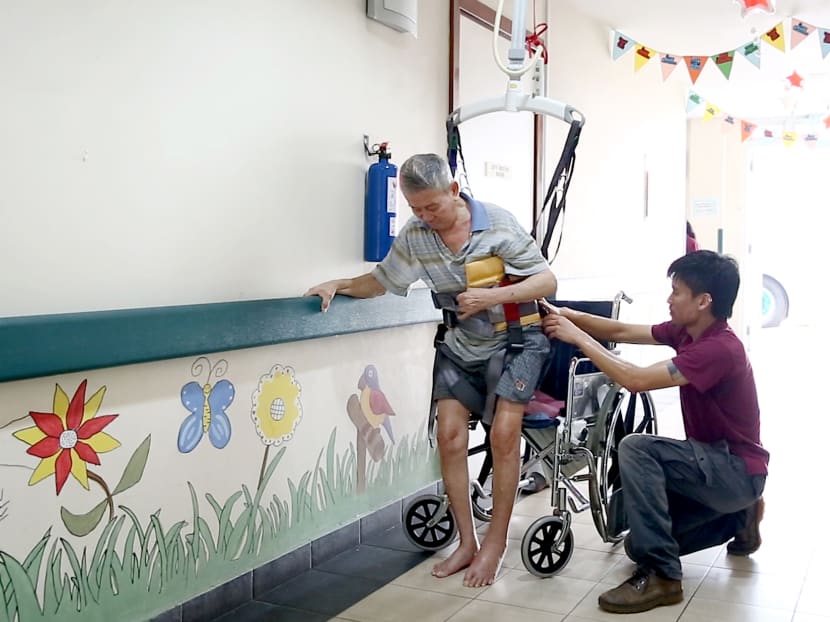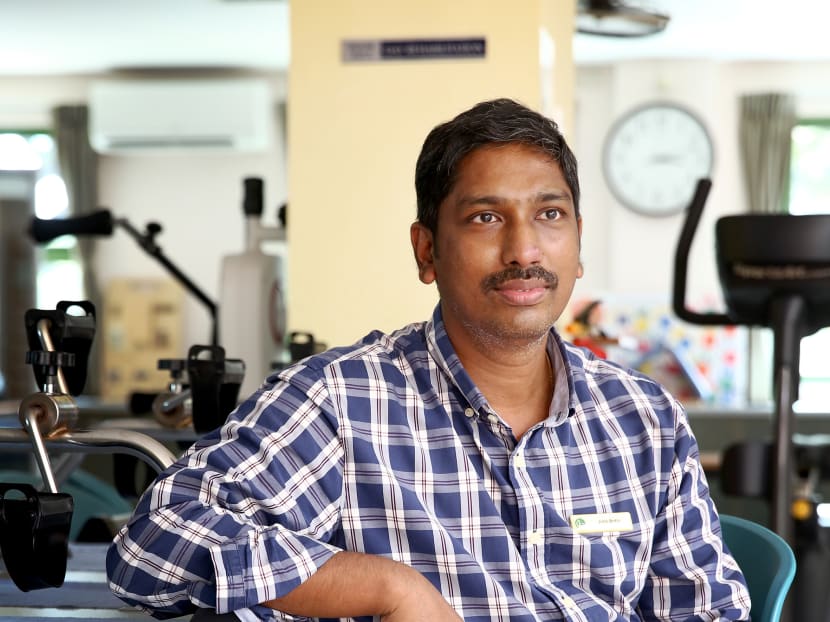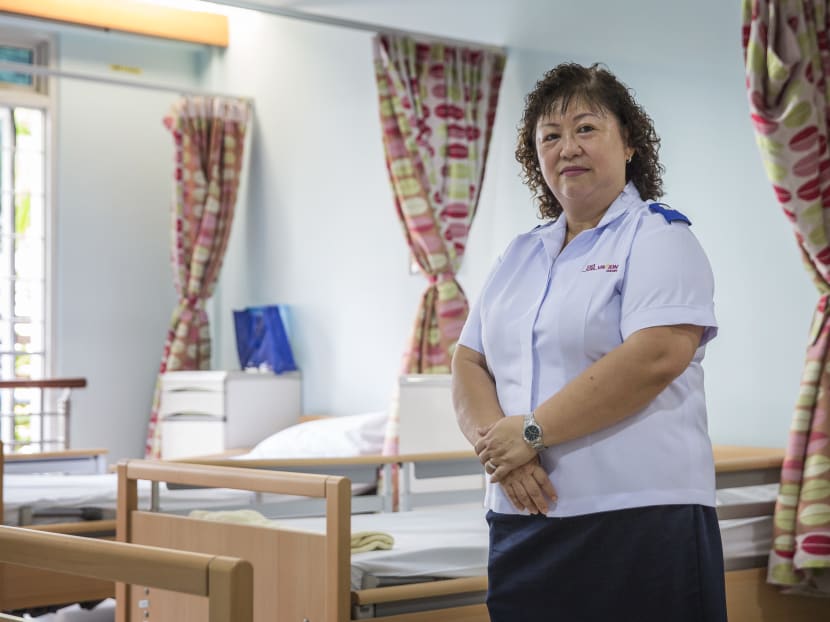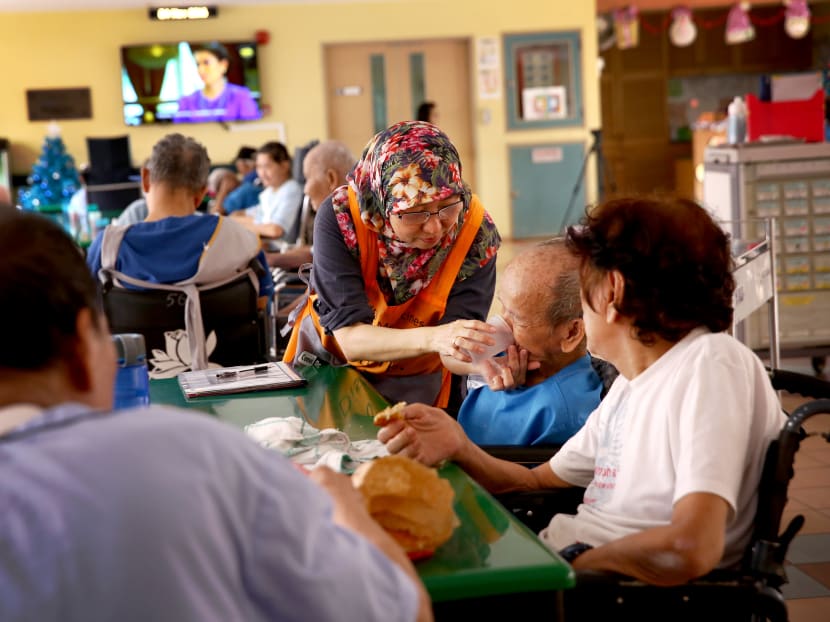The Big Read: Beyond a jobs boost, healthcare sector needs a new model of care, say experts
SINGAPORE — He was hired two years ago as the manager of Jamiyah Day Care Centre, but Mr John Britto soon found himself doubling as head of the centre’s rehabilitation department — which comprises one occupational therapist and a part-time physiotherapist.
SINGAPORE — He was hired two years ago as the manager of Jamiyah Day Care Centre, but Mr John Britto soon found himself doubling as head of the centre’s rehabilitation department — which comprises one occupational therapist and a part-time physiotherapist.
The starved stable of allied health professionals at the centre — 16 employees serving 60 elderly people — has also resulted in employees pulling 12-hour shifts, and making it difficult for them to go on leave.
Over at Peacehaven Nursing Home, Mr Brian Tan, a physiotherapy assistant, also sometimes doubles as an errand boy for jobs that involve heavy lifting “because I am the only young man around” — taking time away from his therapy work.
For Mr Britto and Mr Tan, the news that the Ministry of Health (MOH) hopes to add another 30,000 workers to the healthcare sector comes as a much-needed booster for the intermediate- and long-term care (ILTC) sector, which is expected to bear much of the care demands of a rapidly-ageing population.
But other medical professionals say the issues faced by the healthcare sector require more than a straightforward injection of manpower.
Instead, Singapore needs to transform its current care model to one that makes better use of existing manpower — in particular, the general practitioners (GPs) and family physicians — to focus on preventing people from developing chronic conditions, and on community care.
This is not a new direction for the sector; as far back as 2000, the ministry launched the Primary Care Partnership Scheme and other initiatives to make better use of primary care resources. But limited headway has been made, in part because the care model continues to steer people towards seeking care at hospitals.
“It’s probably not a shortage of doctors but a distribution problem … There is still slack in some areas,” said Dr Phua Kai Hong, Associate Professor of health and social policy at the Lee Kuan Yew School of Public Policy.
“Compared with the rest of the population, our doctor-to-population ratio is decent … It’s not just the numbers but how you use these doctors,” he added.
Within the ILTC sector, practitioners are also urging a shift away from the nursing home model towards providing day care or assisted-living facilities for those who do not need intensive medical attention, to alleviate the burden on nursing homes.
As long as healthcare in Singapore is hospital-centric and “overweighted” towards specialist care, it will continue to face shortages because of the increased number of patients and the onset of chronic diseases, said Dr Jeremy Lim, who leads the health and life sciences and public sector practices of consulting firm Oliver Wyman in the Asia-Pacific.
WHERE THE NEEDS ARE
Today, the healthcare workforce is 91,000-strong — comprising doctors, nurses, allied health professionals, and support-care staff, among others. Meanwhile, there are 460,000 Singapore residents above the age of 65, and this group is expected to increase by 33 per cent to 610,000 by 2020, and to more than double by 2030.
The MOH said that about half of the expected 30,000 healthcare jobs needed by 2020 are expected to be filled by professionals, managers, executives and technicians. These include doctors, nurses, allied health professionals, and managerial administrative staff such as centre managers, operations and administrative executives
“The projected manpower demand will come from across the healthcare settings. Beyond new acute hospitals, there will be demand from primary care with new polyclinics, as well as the community care sector with the expansions of capacity in community hospitals, nursing homes, senior care centres and home care,” said the ministry, in response to TODAY’s queries.
Between 2015 and 2020, the Government wants to add six new polyclinics, 2,100 beds in public hospitals, and 9,100 beds in community hospitals and nursing homes.
Member of Parliament (Tanjong Pagar GRC) Chia Shi-Lu, an orthopaedic surgeon and chair of the Government Parliamentary Committee for Health, said with a revamp of Eldershield on the cards, financing for “post-hospital ILTC sectors” might improve and may increase demand.
Local and foreign recruitment has helped meet demand so far, and efforts to grow the local healthcare workforce include increasing the training pipeline, which has seen local medical and nursing intakes increase by 29 per cent and 17 per cent, respectively, between 2012 and last year.
This year, the Singapore Institute of Technology started four new allied health professional programmes: Physiotherapy, occupational therapy, diagnostic radiography and radiation therapy.
The ministry has also introduced training grants and programmes to woo those seeking a mid-career switch into the sector and to encourage Singaporeans studying health science disciplines overseas to return to practise locally.
And around nine in 10 public sector healthcare professionals who reach the age of 62 are re-employed, while the sector raised the re-employment age for staff from 65 to 67 in July.
Doctors working in acute hospitals told TODAY that growth in the recruitment of foreign doctors has helped make up for the shortfall. As of the end of last year, about 18 per cent of doctors in both public and private healthcare sectors were foreigners.
But Dr Lim said these efforts are “salves rather than fundamental solutions”. A community-centric model of care can tap family physicians to manage “all but the most-complicated cases of diabetes, heart failure and arthritis”, he said.
“Likewise, if nurses and allied health professionals take on more of the junior doctors today undertake, then we would need more nurses and allied health professionals, and may not need more doctors,” he said.
LONG-TERM CARE WORKERS NEEDED, BUT SECTOR HAMPERED BY ‘IMAGE DEFICIT’
The experiences of Mr Britto and Mr Tan reflect the acute manpower shortage in the intermediate- and long-term care sector.

Recruiting has not been easy, as the long-term care industry suffers from an “image deficit” among Singaporeans, said Ms Yorelle Kalika, who founded home-care provider Active Global Specialised Caregivers.
“There is a misconception that because home-based care does not have a professional work environment, like in a hospital or nursing home setting, it is less prestigious,” she said.
Nursing-home employees said Singaporeans shun their jobs, too. “Work in nursing homes tends to be monotonous and routine, and the career progression is not great,” said Mr Britto, a permanent resident who worked in acute and community hospitals before he joined the Jamiyah Day Care Centre.
He also noted that wages are not attractive. Junior therapists earn about S$2,800 a month in nursing homes, compared with S$3,500 for a similar role in hospitals.

Mr Tan, 26, who graduated from the Nanyang Technological University, said that his choice of profession was “unusual” for someone with a degree in sports science: “People told me to go into coaching (athletes), but I felt that working with the elderly made a greater difference. You get to see them improve with your assistance.”
Even if the sector successfully attracts more talent, said Jamiyah Nursing Home director Lai Foong Lian, the Republic will continue to “play catch-up” for some time.
“However fast you want to churn out professionals, it will not meet demand … The training takes three years, and they won’t have practical experience, which is vital for nursing homes,” said Ms Lai, adding that eight in 10 of her employees are foreigners.
This is also the case at Active Global, where 89 per cent of its caregivers are foreigners from Myanmar, Sri Lanka, India, the Philippines and Indonesia.
But depending on foreign workers may not be sustainable, said Ms Lai, as they will gradually return to their home countries.
Peacehaven Nursing Home executive director Low Mui Lang said she tries to vary employees’ job scope by rotating them between the home and its day centres, a move that has improved retention rates.
The home also hires older Singaporeans aged between their 50s and 60s as healthcare associates, and they now make up about 10 per cent of its workforce. Senior employees, still a largely untapped manpower resource across Singapore, are a valuable asset in the long-term care sector because they are conversant in various dialects and wages are not their foremost concern, she said.
Apart from ramping up manpower, another key strategy of the Healthcare Manpower Plan is to tap technology to raise productivity — something already being done across all sectors of care.
Peacehaven Nursing Home and St Andrew’s Community Hospital, for instance, make use of a ceiling track hoist to support patients as they walk from one end of the centre to another.
But technology is costly and might not necessarily be worth the manpower savings: A robotic-assisted bed that alerts staff when a patient gets out of it can cost S$8,000 each.
And healthcare workers cannot be completely replaced by technology. “People say it involves feelings, touch, which are not replaceable. That is why manpower is quite critical,” said Ms Lai.
Dr Chia said the 30,000 manpower projection could be a conservative one and “may not be as much as we need”. Noting that the healthcare sector is prone to “disruption”, he said there could for example be various types of assisted living centres, requiring less manpower than the current type of nursing homes.
Mdm Low agreed, pointing out that a tiered nursing ecosystem comprising nursing homes and “assisted-living facilities” — a housing model popular in Western countries for the elderly who cannot or choose not to live independently — will help to better distribute existing manpower.
Such facilities should house elderly residents who are not chronically ill and will require fewer staff on hand. This will also free up the beds in nursing homes for the bed-ridden and those who require a high level of care, she said.

Peacehaven houses many patients who are fit to be discharged but continue to stay in the nursing home because they have no caregivers.
“We see a higher level of social needs than medical needs among this group of residents. The future model of elderly homes should include the ‘non-sick model’, which may require more social workers than healthcare … If we continue healthcare as we are doing today, it will blow the manpower,” she said, urging the Government to consider assisted-living facilities as it prepares to build new nursing homes.
Assisted-living facilities may be better suited to the needs of seniors who prefer to remain independent, she said. “The next generation of old folks is my generation, and we are the type who want to (remain) as independent as possible.”
RADICAL TRANSFORMATION AND OPTIMISING THE GP POTENTIAL
Noting how Singapore enjoys a “respectable” doctor-to-population ratio, Dr Leong Choon Kit, a GP who also sits on the Singapore Medical Council, called for a paradigm shift to strengthen GPs’ involvement in step-down and chronic care, as well as a greater emphasis on patients’ self-management.
With polyclinics and hospitals bursting at the seams, GPs in private practice can help to offload patients. As of last year, there were 18 polyclinics, and 2,973 GP and dental clinics in Singapore.
GPs can be trained to manage more complex cases without having to refer them to hospitals, unless necessary. This can help reduce the costs to both the patient and the system, he said.
“There is a lot of mismatch currently. If matching is done well, we are even likely to have a glut problem,” said Dr Leong, who operates Mission Medical Clinic in Upper Serangoon.
Public hospitals have been rolling out GP engagement programmes for close to two decades, but results have been piecemeal, he noted.
Dr Jeremy Chan noted that the administration and paperwork involved may deter GPs, who are often one-man operators, from signing up for such programmes.
Oliver Wyman’s Dr Lim said the lack of monetary incentives makes GPs reluctant to focus their practice on chronic care.
“For a whole-system transformation, Singapore needs to be comprehensive, and direct money, prestige and organisational power to the parts of the healthcare value chain that we want to strengthen,” he said.
In a commentary written for TODAY last year, Dr Lim suggested a financing model where the doctors are paid a guaranteed sum per patient for a specified total population. The assurance of income allows doctors to invest the time and resources to proactively enhance systems to care for patients with chronic diseases, he said.
Many patients still head to polyclinics despite long waiting times because they pay far less for consultations there than if they see a GP, said Dr Chan.
With no subsidies for medication, rent and staff, GPs incur higher costs, which are passed on to the patients.
The Community Health Assistance Scheme, which replaced the Primary Care Partnership Scheme, provides subsidies for Singaporeans from lower- to middle-income households for medical and dental care at participating GP and dental clinics.
But this could not bridge the gap between price points because the polyclinics’ subsidies were also enhanced, said Dr Chan. The amount patients pay for medication at a polyclinic may be less than even what the GPs fork out, GPs said.
Dr Leong stressed that Singaporeans should not be looking out only for cheap healthcare. “We must focus on quality and not cheap healthcare,” he said, adding that Singaporeans must take greater responsibility for their personal health.
The authorities and healthcare providers can play a part in facilitating the transformation, he said, such as by incentivising the purchase of healthier food, imposing a sugar tax and encouraging insurance companies to increase premiums for people who are not responsible for their own health.
Dr Lim added: “We should be emphasising preventive health, which is under-used, discouraging consultations for minor ailments that are self-limiting, and doing away with administrative processes that are not medically necessary.”
Patients can be taught to self-manage using gadgets, which can help reduce manual assistance. “Quarterly doctor consultations are then replaced by an annual one, during which all preventive health measures such as vaccinations and screenings are carried out at the same time,” Dr Lim said.
In an effort to encourage residents to care for their health, Peacehaven Nursing Home launched an initiative earlier this month where residents “earn” points for doing exercises that can then be redeemed for “rewards” such as a massage, snacks from a mock provision store or for a karaoke session.
Dr Leong also suggested equipping the younger generations with more “in-depth” medical knowledge, such as how to self-medicate for minor ailments and discern information culled from the Internet.
“We must focus on coordinating healthcare in Singapore. We have a very disjointed health system currently, with brilliance in every sector. We need to train many public health leaders who are both clinicians and administrators to take the lead, and make a deliberate effort to change lifestyle and infrastructure to support those changes,” he said.
Correction: In an earlier version of this report, we said the foreigners made up about 22 per cent of the public and private healthcare sectors. This is incorrect. It is 18 per cent. We apologise for the error.







